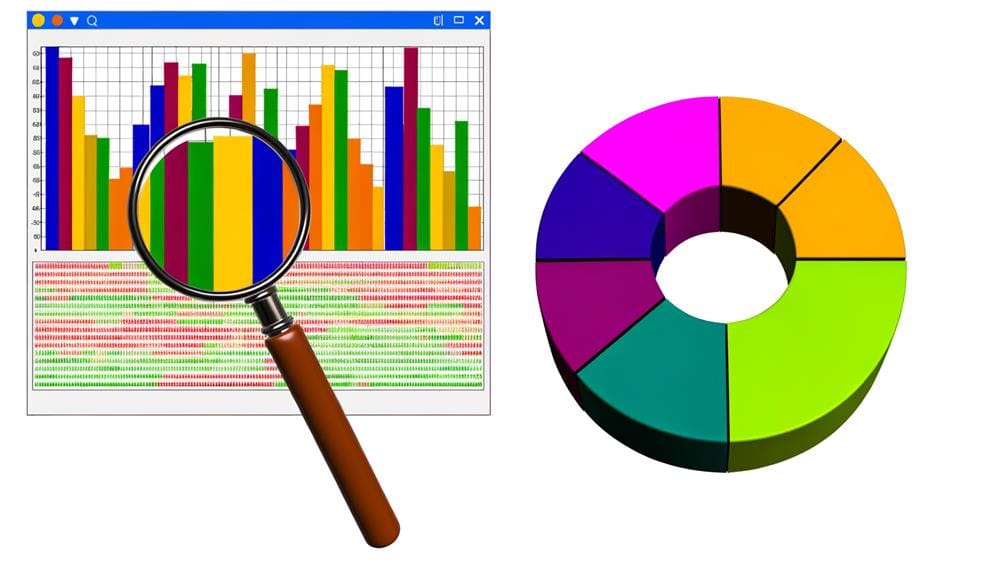To conduct text analysis using Python and Advertools, we must first understand the concepts of word frequency analysis, absolute and weighted frequency. We use the Python library, Advertools, for keyword frequency analysis and to implement weighted word frequency. The methodology of TF-IDF (Term Frequency-Inverse Document Frequency) is valuable for enhancing SEO (Search Engine Optimization) and content optimization. The word_frequency() method in Advertools can be utilized for thorough data analysis. By exploring further, you'll gain a deeper understanding of how to harness data patterns for your SEO and content strategy needs.
Key Takeaways
- Install the advertools library in Python to utilize its text analysis functionalities.
- Use the word_frequency() method in advertools for analyzing keyword frequency.
- Implement weighted frequency analysis with Python and advertools for nuanced interpretation of word importance.
- Use the 'regex' and 'extra_info' parameters in the word_frequency() method for advanced text analysis.
- Apply TF-IDF methodology in conjunction with Python and advertools to optimize content and enhance SEO.
Understanding Word Frequency Analysis
Diving right into word frequency analysis, it's crucial to understand its importance in SEO, where it aids in optimizing content and enhancing user experience. As a fundamental aspect of text analysis, word frequency metrics offer insights into the most commonly used words and phrases in a text document. It's an invaluable tool for SEO content optimization, helping us identify popular keywords and trends. By properly leveraging these results, we can make informed decisions about keyword inclusion and content creation. A balanced approach, using both high-frequency and niche words, can significantly improve our content's relevancy and visibility. So, understanding word frequency analysis isn't just about data—it's about turning that data into actionable strategies to elevate our SEO game.
Importance of Absolute and Weighted Frequency

Understanding the importance of Absolute and Weighted Frequency in text analysis is like unlocking the door to a treasure trove of SEO insights. These frequencies provide valuable text frequency insights, allowing us to identify trends and patterns within the text data.
| Absolute Frequency | Weighted Frequency |
|---|---|
| Shows how often a word appears | Takes into account the importance of each word |
| Great for general overview | Ideal for in-depth, weighted keyword analysis |
| Simple and straightforward | Complex but provides more insights |
| Can be misleading if context isn't considered | Less likely to be skewed by high-frequency, low-importance words |
Python and Advertools for Text Analysis

Having established the importance of Absolute and Weighted Frequency in text analysis, we can now explore how Python, coupled with the advertools library, can streamline this process and provide a more efficient path to valuable SEO insights. Python's advertools library is a potent tool for natural language processing. It offers tailored functions for SEO-specific text analysis, including sentiment analysis techniques.
- With advertools, we can remove stop words, adjust phrase lengths, and focus our analysis on the most critical aspects of our text data.
- The library's functions allow us to analyze word frequencies and distinguish the most significant keywords or phrases.
- By combining Python and advertools, we can access a suite of analytical tools, allowing us to dive deeper into our SEO performance and fine-tune our content strategy.
Enhancing SEO With TF-IDF Methodology

To further enhance our SEO strategy, we'll now explore the use of TF-IDF (Term Frequency-Inverse Document Frequency), a statistical measure that evaluates the importance of a word in a document, based on how frequently it appears in that document compared to its frequency across a set of documents. Applying TF-IDF in text mining allows us to identify relevant keywords, thus improving the specificity of our content. By leveraging TF-IDF for content optimization, we can strategically place high-value words in our content, enhancing our SEO effectiveness. This methodology, combined with Python's data analysis capabilities, allows us to create a nuanced, targeted approach to SEO, ensuring that our content is not only engaging and informative but also highly visible in search engine results.
Keyword Frequency Analysis With Python

Let's dive into how Python, combined with certain libraries like advertools and pandas, can be leveraged for effective keyword frequency analysis, a critical component in modern SEO strategies. Advertools' `word_frequency` function is a powerful tool for keyword extraction, allowing us to analyze text data and determine the frequency of keyword occurrences.
- Implementing NLP techniques, we can extract meaningful patterns and trends.
- Text mining allows us to dig deep into our data, uncovering valuable insights.
- Data visualization is crucial to presenting these insights in an understandable manner.
Through these practices, we're able to uncover the significance of different keywords, thus informing our SEO strategies. Understanding keyword frequency aids in content optimization, ultimately enhancing visibility and reach.
Implementing Weighted Word Frequency

Building on our understanding of keyword frequency, we now turn our focus towards implementing weighted word frequency, a sophisticated approach that affords a deeper insight into the importance of words based on their impression amount. This method gives additional weight to words that appear more frequently, allowing for a nuanced weighted frequency interpretation. We'll use Python and Advertools for this process, leveraging their performance optimization techniques. We'll calculate the weighted frequency of each word, taking into account its impression amount. This advanced approach provides a more accurate measure of word importance than simple keyword frequency. It's crucial not to confuse this with the next topic, 'Analyzing Data With Wtd_Freq and Rel_Value', which will delve into further analysis of our weighted word frequency data.
Analyzing Data With Wtd_Freq and Rel_Value

Delving into the heart of our data, we uncover the significance of the 'wtd_freq' and 'rel_value' columns, vital tools in our quest to understand the efficiency of word frequency in our content. The 'wtd_freq' column allows us to identify and analyze data outliers with accuracy, while the 'rel_value' column aids in measuring the relative importance of each word or phrase in our dataset.
- 'wtd_freq' helps pinpoint patterns and unusual data points that may affect our content's performance.
- 'rel_value' offers insight into how each word contributes to the overall content strategy.
- Together, they form the foundation of effective text analysis visualization techniques.
These columns not only enhance our understanding of the data but also guide us towards making informed decisions for content optimization and SEO strategies.
Advanced Attributes of Word_Frequency() Method

Diving into the advanced attributes of the word_frequency() method, we uncover the power of the 'regex' and 'extra_info' parameters, tools that exponentially enhance our text analysis capabilities. With 'regex', we can decide on different splitting rules, allowing us to detect and isolate specific patterns in our text, greatly aiding in sentiment analysis. Meanwhile, 'extra_info' helps in text summarization by providing additional layers of information such as cumulative and percentage frequencies. These parameters work in tandem to help us better understand the nuances of our text data. This deeper level of analysis allows us to draw more precise conclusions and make smarter, more informed decisions in our data-driven projects.
Applying Text Analysis to Social Media Data

Harnessing the power of Python and its libraries, we can effectively apply text analysis techniques to social media data, a treasure trove of insights that can further enhance our SEO strategies and content optimization efforts. With sentiment analysis, we can gauge public opinion and emotions towards certain topics, products or services. We can identify social media trends by analyzing the frequency and context of keywords used over time.
To evoke emotion, consider:
- The excitement of uncovering hidden patterns and trends within vast amounts of social media data.
- The satisfaction of accurately gauging public sentiment, leading to more effective marketing strategies.
- The thrill of staying ahead of the curve by quickly identifying and adapting to emerging social media trends.
Recommendations for SEO Success

Moving forward in our journey towards SEO success, it's vital that we continuously refine our text analysis skills using Python, keeping abreast of the latest methodologies and libraries. Our SEO strategies must evolve, leveraging Python and Advertools for word frequency analysis and content optimization. We recommend using absolute and weighted frequency analyses, combined with other methodologies like TF-IDF, for high-quality content and improved SEO performance. The advertools library simplifies this process, providing functions for stop word removal and phrase length adjustment. It's also beneficial to explore the use of extra attributes of the word_frequency() method, such as the regex and extra_info attributes, for a more comprehensive and efficient analysis.
Resources for Further Learning

To continue enhancing our SEO strategies and Python skills, it's important that we engage with a plethora of resources for further learning. The digital landscape is teeming with informative materials that can deepen our understanding of text mining techniques and machine learning applications in SEO.
- Online tutorials and courses: Websites like Coursera, Khan Academy, and Codecademy offer comprehensive lessons on Python, text mining, and machine learning.
- Books and Journals: In-depth texts like 'Mining the Social Web' and 'Python Machine Learning' offer detailed insights.
- Python and SEO Communities: Online communities such as StackOverflow and SEO Chat can provide real-time assistance and discussions.
Let's commit to continual learning, keeping us on the cutting edge of SEO strategies and Python applications.
Frequently Asked Questions
How Does Text Analysis Contribute to Improving Business Marketing Strategies?
We're well aware that 84% of companies who've adopted text analysis have seen an improvement in their business strategy. By implementing sentiment analysis, we can dive deeper into customer feedback, understanding their needs and wants more accurately. This leads to effective content optimization, ultimately enhancing our marketing strategies. By identifying trends and patterns in customer behavior, we're able to fine-tune our approach and tailor our content to their preferences.
What Are Some Common Challenges Faced During Keyword Frequency Analysis?
We often face challenges in keyword frequency analysis, notably keyword ambiguity and sentiment interpretation. Identifying the correct meaning of ambiguous keywords in various contexts proves difficult. Moreover, interpreting sentiment isn't always straightforward. Negative words in a positive context or sarcasm, for example, may skew results. Thus, these issues necessitate sophisticated analytical tools and techniques to ensure the reliability and accuracy of our text analysis.
Are There Any Alternatives to Advertools for Performing Text Analysis in Python?
We've explored alternatives to Advertools for Python text analysis. Libraries like NLTK, Gensim, and Spacy are quite efficient. When comparing Advertools, we've found that while it excels in SEO-oriented tasks, Gensim's strength lies in topic modeling, NLTK is great for linguistic analysis, and Spacy shines in entity recognition. Each tool has its unique strengths and choosing the right one depends on the specific requirements of the text analysis project.
How Can I Apply the TF-IDF Methodology in Languages Other Than English?
We're tackling multilingual NLP challenges, like applying the TF-IDF methodology in languages other than English. It's not a walk in the park. Different languages have unique nuances, making sentiment analysis tricky. We're using libraries like NLTK or TextBlob for the task, but there's a catch – they're primarily English-focused. So, we're exploring other tools like Polyglot or langid.py, which offer broader language support, to get the job done.
Can Text Analysis Be Used to Predict Future Trends or Consumer Behaviors?
Yes, we can use text analysis to predict future trends or consumer behaviors. By applying predictive modeling techniques to text data, we're able to identify patterns and anticipate future outcomes. In addition, consumer sentiment analysis lets us understand public opinion towards products or services, which can guide business strategies. It's a complex process, but with detailed, technical analysis, it's possible to make informed predictions.




